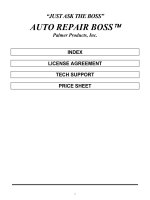Green Zia Environmental Excellence Program Auto Repair Shops potx
Bạn đang xem bản rút gọn của tài liệu. Xem và tải ngay bản đầy đủ của tài liệu tại đây (422.93 KB, 99 trang )
.
.
.
.
.
.
.
.
.
.
Green Zia Environmental
Excellence Program
Auto Repair Shops
Guidance for improved environmental
performance and pollution prevention in
your auto repair business
Green Zia Environmental Excellence Program
New Mexico Environment Department
Office of the Secretary
PO Box 26110
Santa Fe, NM 87502
505-827-0677
Acknowledgements
The material in this workbook is based on the Systems Approach to
Pollution Prevention, developed by Dr. Robert Pojasek of Pojasek and
Associates, and the Nothing to Waste Manual developed by US
Environmental Protection Agency Region 1. Process maps were developed
by Ms. Alicia Hale of Los Alamos National Laboratory.
This manual is printed on recycled paper. The manual printing and
distribution is supported through funding provided by the US Environmental
Protection Agency. Special thanks to Rob Lawrence, Eli Martinez and Joy
Campbell of the US Environmental Protection Agency for their help in
funding this project and in supporting pollution prevention in New Mexico.
Table of Contents
Introduction to Green Zia Program…………….…………………………… … Page 1
Green Zia Tools for Auto Repair Shops…………….…………………………… Page 5
Process Maps for Auto Repair Shops………….…………….………….… …… Tab 1
Auto Repair Shop Regulatory Guidance, Pollution Prevention Ideas
and Other Resources…………………………………………… ……….…… ….Tab 2
This page left blank intentionally.
.
.
.
.
.
.
.
.
.
.
The Green Zia
Environmental Excellence
Program
Guidance materials for auto repair shops
Introduction
This packet contains information on how to establish a pollution prevention program
specifically for an auto repair shop. The packet also contains waste management and
regulatory guidance materials to help you assure that you are in compliance with
environmental, health and safety regulations. Used together, this program can help you
establish a pollution prevention program that will help you meet compliance and reduce
waste. Use of the tools from start to finish helps you qualify for the Green Zia
Environmental Excellence Program!
The Green Zia Environmental Excellence Program is a voluntary program designed to
help New Mexico businesses achieve environmental excellence through pollution
prevention programs, based on quality management principles. This program is
administered by a partnership of state, local and federal agencies, academia, private
industry and environmental advocacy groups. This packet has been specifically
developed for an auto repair shop and is designed to meet the needs of a small business.
The basic logic of the Green Zia Environmental Excellence Program is:
• Waste or pollution is the result of inefficiency;
• Reducing waste increases profits;
• Waste that is not created cannot pollute.
This guidance has been developed to help your company understand best management
practices to help your company comply with environmental, health and safety regulations
and to help your company reduce waste and associated liabilities.
It is important to remember that environmental health and safety regulations are triggered
by the use of equipment and chemicals. Better use of chemicals, use of safer chemicals
and efficient operation of machinery can help reduce your regulatory burden…if you
aren't using hazardous materials, then you have fewer regulations to be concerned with!
This program is based on first understanding work process and materials use and then
improving work practices to reduce cost, waste and regulatory concerns.
Working through the Green Zia Environmental Excellence Program will result in a
system that helps address environmental issues in cost effective ways, based on sound
business practices. The system provides a framework for continuous improvement over
time and contributes to a thorough understanding of environmental issues in your
business.
What is Pollution Prevention?
Simply put, pollution prevention means not creating a waste in the first place. Pollution
prevention is achieved by the efficient use of resources, including raw materials, energy,
water and even time and distance. The goal is to produce a product or deliver a service as
efficiently as possible, with the least amount of wasted materials and the least possible
environmental impact.
The bottom line is that pollution prevention or improved efficiency can help businesses
save money and help protect the environment at the same time.
What is Environmental Excellence?
Environmental excellence means moving beyond compliance with environmental, health
and safety regulations by establishing an environmental management system that
incorporates pollution prevention into core business practices.
A prevention-based environmental management system will:
• Help a business identify all the environmental compliance and health and safety
concerns as well as costs associated with a waste generating process, and
• Use prevention approaches to reduce or eliminate the waste and reduce the associated
costs.
In the Green Zia Environmental Excellence Program, attention is focused on the process
that generates the waste, not the waste. Identifying and implementing process
improvements will reduce waste and costs. This is a major shift from the traditional,
reactionary approach that concentrates only on managing wastes or pollutants already
created to an anticipatory approach that concentrates on prevention of wastes or
pollutants to improve environmental and economic performance. This prevention-first
environmental management system will identify cost effective ways to achieve "beyond
compliance" status, creating a win-win situation between economics and environment.
Knowledge of
Process
Full Cost
Accounting
Pinpointing
Problems
Creative Problem
Solving
Prioritization of
Options
Ensuring Success
The Green Zia Tools
The Green Zia Program provides tools to establish a basic prevention-based
environmental management system. Management and employees walk through the tools
as a team to gain a complete understanding of their operation. Examples have been
worked out for the auto repair business. We encourage you to customize the examples to
your own operations. The packet includes a series of process maps (Tool 1) for some
operational areas of the auto repair business. Tools 2-6 are also explained and illustrated
to help you develop your program. Use of these tools on a regular basis will help your
company qualify for the Green Zia Environmental Excellence Program.
Green Zia Tools:
Tool 1: Process Mapping: Illustrates the work steps materials pass through
as they are transformed into your final product. Maps allow for the
identification of all inputs and outputs such as water, chemicals, electricity or
other materials from a process, helping you to understand wastes and their
sources. Maps also help you understand regulated activities.
Tool 2: Activity-Based Costing: Identifies the true costs of wastes or losses
and helps participants identify areas to target for pollution prevention, by
assigning dollar values to these wastes and losses.
Tool 3: Root Cause Analysis: Creates a cause and effect diagram to
highlight why and where the losses occur in the process. Understanding why
and where the loss occurs will help participants focus on specific areas for
improvement.
Tool 4: Brainwriting: Addresses problems by generating as many
alternatives as possible to minimize loss.
Tool 5: Bubble-up-bubble-down: Ranks alternatives to determine the
optimal solution. Factors such as cost, ease of implementation and
effectiveness are considered in evaluating and ranking the alternatives.
Tool 6: Action Plan: Details each step that needs to be taken to implement
the alternative and reduce or eliminate the loss from the process.
Tool #1: Process
Mapping
To begin incorporating pollution prevention into your business,
you must first get a full understanding of where wastes are being
generated. This tutorial will discuss the advantages of using
process maps to logically evaluate each step of your process.
Warm-up Exercise
Maps have been used throughout the
ages for many purposes from helping
sailors navigate the seas to providing a
safe route for climbers hiking to the
tallest peaks. You have probably drawn
maps to your home or office so that
someone could visit. It is important that
the information on this map is complete
and accurate or, as you may have found,
your guest will get lost!
Take a minute now and think of a coffee shop or restaurant nearby that everyone in the
group knows. Draw a map from the building you are currently in to this establishment -
include traffic lights, landmarks, and any other important features along the way. Now
compare maps with the other members of your group. Are they the same? If a person
not familiar with the area were to use your map, would they have found their way?
Introduction
Are you aware of the amount of waste that your business generates? Could this waste be
turned into profit? By considering methods of reducing wastes, recycling used and
unused raw materials, and reusing lost material you could not only help the environment
but also reduce your raw material and waste disposal costs.
This section discusses process mapping, a method of analyzing a process in order to
catalogue all the materials used and lost in the process. With process mapping, you will
systematically identify the series of steps materials pass through as they are transformed
into the final product. Evaluating your process in this manner will allow you to recognize
the opportunities to prevent losses and possibly streamline operations. Each loss
identified during the process mapping is an opportunity to prevent that loss.
Create a team of employees to complete this exercise. During this exercise you will:
• Examine and revise the process maps and narratives in the packet to accurately reflect
your operation.
• Fully understand the functionality of each step of a process.
• Identify the inputs and outputs/losses within the process.
• Communicate findings in a clear and concise manner to members of the team.
Process Mapping
A series of process maps have been developed for auto repair operations and are included
in this packet in Section 3. You should customize these maps for your operation, since
no two businesses are exactly alike. These maps become a reference for you to use for
your pollution prevention program and can be updated to reflect changes as you improve
your operations. These maps are also great for training new employees and other
problem solving needs.
Large businesses and manufacturers use these tools to understand and improve their
manufacturing processes. Small businesses can benefit by using these tools as well!
It is helpful to also prepare a narrative to go along with your process maps to explain the
process in detail. We recommend that you include regulatory activities in the narratives
as part of your environmental management system. Narratives are also included in this
packet; please revise to reflect your business operations.
Example of a process map for General Auto Repair:
Please review the process maps in Section 3. in the back of this booklet and make
changes to reflect your operation.
Once you have reviewed and revised the process maps to your
operation, move to the next section…Activity-Based Costing!
Remove Defective Part Clean Repairable Part
Prep Vechicle
& Assess Problem
Check
Repair
Replace Part
Prepare to Return
to Customer
Paper on
Floor Mats
Plastic on
Seats
Rags
Solvent
Rags
Dirty
Solvent
Rags
Waste
Fluids
Dirty
Rags
4. General Auto Repair
4.1
4.2 4.3
4.4 4.5
4.6
Spent
Soap
Paper on
Floor Mats
Water
Energy
Rags
Soap
Dirty
Rags
Dirty
Water
Solvent
Clean Up
Materials
Rags
Dirty
Solvent
Dirty
Rags
Clean Up
Materials
Plastic
on Seats
Tool #2: Activity-Based
Costing
Every waste or environmental loss costs you money. By determining the
activities that cause waste, you can focus your pollution prevention efforts to
minimize the cost to your business and protect the environment. This tutorial
will introduce you to a method of evaluating your waste.
Warm-up Exercise
Your daughter approaches you one evening and says that she is planning to buy a car.
With the $400 she has left over each month, after
paying all of her bills, she is sure she will be able to
afford the $220 monthly car payment.
What are the other costs of operating and maintaining
a car that she is forgetting? Consider not only the
annual costs, such as insurance, but also the intermittent (once in a while) costs. Can she
really afford this car?
Introduction
Once you have determined the losses in your processes through your process maps, you
can discover how these losses are affecting your "bottom line". How much does it cost
you to discard 10% of your raw materials, or 2% of your finished products? Which
activities have losses that most hurt the profitability of your company? This tool will
help you look at the cost of the losses in your business and see how much these losses are
costing you. The results may surprise you!
Which losses should you care about? The Pareto Principle suggests that 80% of the
problems in a business come from 20% of machines, raw materials or operators. (The
same is true for any facet of a business, for example, 80% of sales come from 20% of
your customers, etc.) Once you have assigned costs to your activities, you can figure out
which 20% of your activities are contributing to 80% of your costs. The Pareto Principle
is very important in activity-based costing as it is used to focus on the most important
areas for improvement in your pollution prevention program. Use of the Pareto Principle
for the activity-based costing section will help you quickly identify areas of your business
to focus your prevention efforts.
New Terms
Activity based costing (ABC) - An accounting method used to assign the cost of your
losses to the activities that generate these losses. By assigning costs to activities, you will
discover the activities should be targeted for prevention.
Environmental costs -The costs associated with the losses in your process.
Intermittent operations – Operations that occur once in a while.
Pareto principle - A principle that suggests that 80% of anything can be attributed to 20%
of the factors involved. For example, 80% of your environmental costs can be attributed
to 20% of your activities.
Activity-Based Costing
1. Make a list of all the activities in your operation. Be sure to include the activities
from your process map as well as any intermittent operations (such as cleaning or
maintaining equipment.).
Regular activities:
• Tire replacement
• Radiator flush and drain
• Air conditioning repair
• General auto repair
• Changing brakes
• Oil changes
Intermittent activities:
• Recycling antifreeze
• Parts cleaning
• Recycling solvents
• Waste oil management
2. List all of the losses in your operation. Look on your process map and add any others
that you think of.
3. Reviewing your process maps, identify the operations in your shop that generate most
of your waste or pollution problems. For example, does solvent use cause most of
your environmental problems? Does the 80/20 Rule apply? Focus your efforts for
now on the areas of your operations that you do the most or that create the biggest
environmental problem for you.
4. Use process maps to review material use and losses for your selected process or
operation…you will use these maps as a guide to assign costs to these losses.
5. Identify which major costs or general ledger costs apply to the material use and losses
on the process maps (utilities, chemical purchase costs, waste disposal costs, costs
that are easy to get information on and that you typically consider when looking at
your processes). Enter into Table 1. (See example provided)
6. Identify which other activities are related to the use of these materials that are not in
the major costs (protective equipment such as gloves or, monitoring, record keeping,
maintenance, compressors to run equipment, permits, fees to the state or city, storage
space for chemicals, the cost of spill clean-up and reporting, etc). These activities
are not usually considered when thinking about the cost of a process, yet the costs
associated with them can be significant!
7. Write the activities in the first column of Table 2. Along the top list all the costs or
services required for these activities. Add or delete categories as appropriate for your
business. Put an "x" for every cell that applies.
8. Count the total number of "x's" in Table 2. Then circle the x’s that represent what
you estimate to be about the top 20% of the most expensive activities in your
operation. Again, you are using the 80/20 rule: 20 percent of your activities will
probably add up to about 80% of your total costs.
9. Then only estimate the cost of each of these top activities that you circled and write
them in a new table. Cost estimates are allowable as you are using this method to
prioritize your most expensive activities. You can refine costs once you have chosen
a project to work on. (In the example, the top 20% of the cost categories chosen have
the estimate beside them.) Add these numbers into Table 1 under the appropriate
waste stream in the "Hidden costs" line.
10. Add the ledger costs and the hidden costs together to discover the true costs!
11. Create a Pareto Chart. Create a chart showing all these costs graphically. On the x-
axis, place costs in dollars, on the y axis (horizontal), show the true costs of the
wastes. This chart will help graphically show how all the costs stack up against each
other. Does the 80/20 Rule apply here? Use this chart to identify the most expensive
processes. This can be used to identify the first area for improvement! Which waste
stream do you think you should focus on from this Pareto chart?
Activity-Based Costing Example
Activities Materials and Losses
Tire Replacement
Radiator Flush and Drain
Air Conditioning Repair
General Auto Repair
Parts Cleaning
Brake Change
Oil Change
Wheel Covers
Lug Nuts
Lead Weights
Valve Stems
Waste Water
Antifreeze
Lead Solder
Hoses
Clamps
Air Emissions
*Solvent Use
Rags
*Clean Up Material
*Brake dust
Metal shavings
Energy
Personal Protection Gear
*Solvent Sludge
*Fugitive vapors
*Filters
Oil Filters
Oil
(*) Indicates most important waste streams
and materials
Remove Defective Part Clean Repairable Part
Prep Vechicle
& Assess Problem
Check
Repair
Replace Part
Prepare to Return
to Customer
Paper on
Floor Mats
Plastic on
Seats
Rags
Solvent
Rags
Dirty
Solvent
Rags
Waste
Fluids
Dirty
Rags
4. General Auto Repair
4.1
4.2 4.3
4.4 4.5
4.6
Spent
Soap
Paper on
Floor Mats
Water
Energy
Rags
Soap
Dirty
Rags
Dirty
Water
Solvent
Clean Up
Materials
Rags
Dirty
Solvent
Dirty
Rags
Clean Up
Materials
Plastic
on Seats
Table 1. Activity-Based Costing Analysis (Per year)
Workstep
Costs
/Losses
Fugitive
Vapors
Solvent
Sludge
Brake Dust Solvent
Use
Filters Clean Up
Material
Total
Labor $1,000 $700 $800 $600 $3,100
Raw
material
$5,000 $850 $1,500 $7,350
Disposal
fees
$2,500 $500 $100 $3,100
Other
ledger
costs
$150 $150
Hidden
Costs
($1,240) ($4,550) ($150) ($3,650) ($2,000) ($500) ($12,090)
Total $1,240 $8,050 $1,350 $8,650 $3,650 $2,850 $25,790
%of Total 4.8 31.2 5.2 33.5 14.2 11.1
Table 2. Hidden Cost Analysis (per year)
Fugitive Vapors
Activities/Cost
Factors
Materials Space Utilities Services Labor
Monitoring X ($200) X ($1040)
Reporting x x
Repairs x x x
Total hidden costs for vapors ($1,240)
Solvent sludge
Muck
out/disposal
x X ($2,050)
Spill clean-up x x x
Storage x x x
Record
keeping
x x X ($1,000)
Generator fees x X ($1,500)
Total hidden costs for sludge’s ($4,550)
Brake Dust
Storage x X ($150) x
Total hidden costs for brake dust ($150)
Solvent Use
Record
keeping
x x
Permit fees x
Permit X ($3,000) X ($650)
Storage x x x
Spill/clean-up x x x
Total hidden costs for new solvent ($3,650)
Filters
Disposal x x X (1,500)
Repairs x x X ($500)
Total hidden costs for filters ($2,000)
Clean Up Materials
Handle/dispose x X ($500)
Total hidden costs for clean up materials ($500)
Pareto Chart for Auto Repair Shops. The Pareto Chart illustrates costs relative to each
other and helps choose areas to target for pollution prevention activities. In this example,
solvent use, the most expensive loss, will be the focus of the pollution prevention efforts
in the following sections. Please note that the cost examples provided in this workbook
are not from an actual case study but are used only to illustrate the use of the tools.
Now that we have completed the process mapping and activity-based costing, we have a
sense of the relative environmental costs of our operations. Since solvent use is our
target, we will use the following problem solving and decision-making tools to find a
way to reduce solvent use, increase efficiency and save money.
Most of your work is done. These two tools can be revised as needed. Use
these maps and information annually (or more often!) to keep improving
your operation on an ongoing basis. Now that you have identified your
most expensive wastes, you can now move towards solving problems and
eliminating waste…the next tool is Root Cause Analysis!
Environmental Costs
$0
$2,000
$4,000
$6,000
$8,000
$10,000
Solvent
Use
Solvent
Sludges
Filters CleanUp
Materials
Brake
Dust
Fugitive
Vapors
Resources Used and Lost
Annual costs
Table 1. Activity-Based Costing Analysis (Per year)
Workstep
Costs/Losses
Total
Labor
Raw
material
Disposal
fees
Other ledger
costs
Hidden
Costs
Total
%of Total
Table 2. Hidden Cost Analysis (per year)
Activities/Cost
Factors
Materials Space Utilities Services Labor
Waste Stream
Monitoring
Reporting
Repairs
Muck
out/disposal
Spill clean-up
Storage
Record
keeping
Generator fees
Total hidden costs for (waste stream)
Waste Stream
Monitoring
Reporting
Repairs
Muck
out/disposal
Spill clean-up
Storage
Record
keeping
Generator fees
Total hidden costs for (waste stream)
Waste Stream
Monitoring
Reporting
Repairs
Muck
out/disposal
Spill clean-up
Storage
Record
keeping
Generator fees
Total hidden costs for (waste stream)
Tool #3: Root Cause
Analysis
Now that you have recognized the activities in your process that are costly
or expensive to your business, you can begin to focus your efforts on
pollution prevention. This tool presents a method of detecting the underlying
reason for an environmental loss so that the loss can be prevented.
Warm-up Exercise
Think of all of the times that you have been late for work and
list the different reasons for your delay. Maybe your alarm
clock did not go off, or perhaps your child was sick and you
needed to arrange for a sitter. Did you spend too much time
reading the newspaper or did you need to run to the store to
pick up milk.
Arrange all these reasons in the categories listed below, or
create an additional category. Some of the items on your list
may be entered more than once.
Now consider the last time you were late for work. Why were
you late? Circle the reason.
MACHINES PEOPLE
broken alarm clock sick child
METHODS MATERIALS
reading the newspaper out of milk









